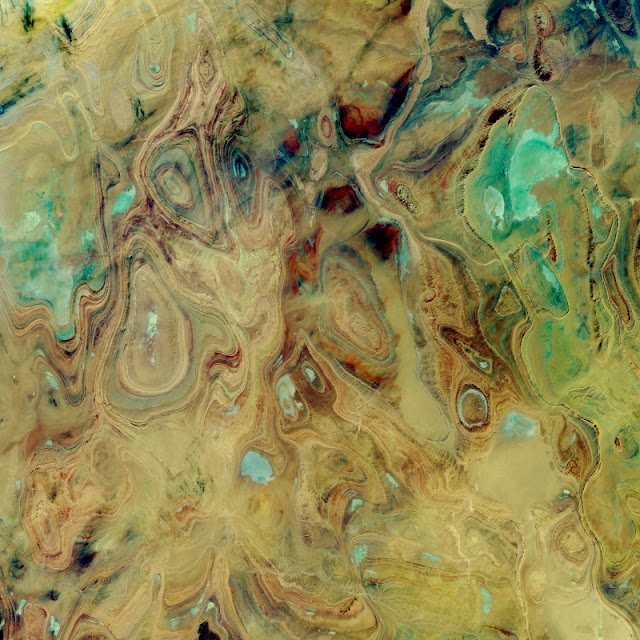February 20, 2018
You may have seen some of the spectacular images of the
earth in southern Algeria, curves and colors like some Picasso in the opposite
of his cubist period. If you haven’t, check out the one from NASA, below.
The ovals and swirls, with their concentric bands, are
immediately obvious to a geologist as patterns of folds, but not just linear
folds like many anticlines and synclines form. These closed ovals represent
domes and basins – imagine a large scale warping, both up and down, in a thick
succession of diverse sedimentary rocks, like sets of nested bowls, some of
them right-side up and some inverted, then all sliced off halfway through.
But “obvious to a geologist” has plenty of limitations in a
space image. Without knowing more information, it’s difficult to be sure if an
oval is a basin or a dome. And you can speculate, but without some ground
truth, it’s challenging to be sure what the rock types are.
This area, called the Ahnet-Mouydir, on the flank of the Hoggar Mountains close to the middle of the Sahara Desert, is remote, inhospitable, and arid, and called the “land of terror” for a reason. The rocks represent a thick sequence of marine sandstones, shales, and limestones, spanning a huge range of ages, from at least the Ordovician to the early Carboniferous – 150 million years or more, a great chunk of the Paleozoic era.
 |
| Ahnet-Mouydir, Hoggar Mountains, Algeria. NASA image - source |
This area, called the Ahnet-Mouydir, on the flank of the Hoggar Mountains close to the middle of the Sahara Desert, is remote, inhospitable, and arid, and called the “land of terror” for a reason. The rocks represent a thick sequence of marine sandstones, shales, and limestones, spanning a huge range of ages, from at least the Ordovician to the early Carboniferous – 150 million years or more, a great chunk of the Paleozoic era.
The core of the Hoggar Mountains is an old Precambrian
block, not as big as the cratons and shields that form the hearts of most of
the continents, but otherwise similar. It might have been something like a
microcontinent that became amalgamated into the growing supercontinent of
Gondwana about 600 million years ago. After that amalgamation, seas came and
went much like they did in western North America throughout much of the
Paleozoic era, laying down the sediments that became the rocks we see today in
the northern Hoggar Mountains.
That’s all well and good – but here’s the next question, how
did the rocks get deformed into these oval domes and basins? If you imagine the
kinds of collisions that are typical on earth, you think of linear or
curvilinear things – island arcs, edges of continents and such – that when they
collide, are likely to make linear belts of deformation. This is why so many
mountain ranges are long, l
Mark as Played
Popular Podcasts
Stuff You Should Know
If you've ever wanted to know about champagne, satanism, the Stonewall Uprising, chaos theory, LSD, El Nino, true crime and Rosa Parks, then look no further. Josh and Chuck have you covered.
Dateline NBC
Current and classic episodes, featuring compelling true-crime mysteries, powerful documentaries and in-depth investigations. Follow now to get the latest episodes of Dateline NBC completely free, or subscribe to Dateline Premium for ad-free listening and exclusive bonus content: DatelinePremium.com
The Breakfast Club
The World's Most Dangerous Morning Show, The Breakfast Club, With DJ Envy, Jess Hilarious, And Charlamagne Tha God!